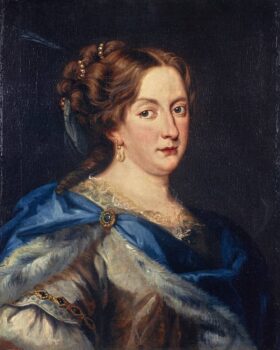Christina, Queen of Sweden: A Life of Mystery, and Controversy
Christina, Queen of Sweden, is one of the most fascinating and enigmatic figures in European history. Born in 1626, she ruled Sweden from 1632 to 1654, a period marked by political upheaval, religious tension, and the shifting alliances of Europe’s Thirty Years’ War. Her life story intertwines power, intellect, controversy, and mystery, making her a subject of enduring fascination for historians and enthusiasts alike. But who exactly was Christina, and why does her legacy remain a source of intrigue centuries later?
Early Life: The Making of a Queen
Christina was born on December 18, 1626, in Stockholm, Sweden, to King Gustav II Adolph and Maria Eleonora of Brandenburg. Her father, Gustavus Adolphus, was a formidable ruler whose military prowess during the Thirty Years’ War earned him the title “The Lion of the North.” Christina’s upbringing, however, was unconventional for a princess. King Gustav insisted she receive an education comparable to that of a prince. She studied philosophy, theology, history, mathematics, and multiple languages. Christina was precocious, intellectually curious, and fiercely independent, qualities that would define her reign.
Tragically, Christina never knew her father, who died in 1632 during the Battle of Lützen, leaving her a queen at the tender age of six. Her reign began under the guidance of a regency council led by Axel Oxenstierna, Sweden’s powerful chancellor, who managed state affairs until she came of age. From an early age, Christina displayed an intense interest in the arts, literature, and the pursuit of knowledge, laying the groundwork for her reputation as a learned and unconventional monarch.
What Was Christina of Sweden Known For?
Christina’s fame rests on a combination of her intellectual brilliance, her patronage of the arts, her bold personal choices, and her unique approach to monarchy. She is particularly known for:
Her Patronage of Arts and Culture: Christina transformed Stockholm into a vibrant cultural hub. She invited scholars, artists, and philosophers from across Europe to her court, including the philosopher René Descartes, who spent his final years in Sweden under her patronage. Christina’s court became synonymous with intellectual discourse, artistic innovation, and cultural exchange.
Her Unconventional Lifestyle: Christina rejected many of the traditional expectations of royal women. She dressed in male clothing, engaged in traditionally male activities such as horseback riding and fencing, and avoided marriage, an act that shocked her contemporaries. Her behavior challenged gender norms and made her a symbol of independence and nonconformity.
Religious Ambiguity: Christina was raised Lutheran but was fascinated by Catholicism. In 1654, she converted to Catholicism, a move that was controversial in Protestant Sweden. Her conversion sparked political tension and created a scandal across Europe.
Abdication and Political Drama: Christina is perhaps most famous for her unexpected abdication in 1654. She voluntarily gave up the throne of Sweden in favor of her cousin Charles X Gustav, a decision that stunned the political world. Her abdication reflected both her personal independence and the broader tensions between her intellectual and spiritual inclinations and the demands of monarchy.
Controversies and Mysteries: Why Is Christina a Historical Enigma?
Christina of Sweden has long been considered a controversial and mysterious figure, not only because of her lifestyle and abdication but also due to the intrigue and speculation surrounding her life. Several factors contribute to her enigmatic reputation:
Her Gender Nonconformity: Christina’s deliberate defiance of gender norms sparked widespread speculation. Contemporary observers found her behavior so unconventional that rumors circulated regarding her sexuality and her refusal to marry. She became a subject of gossip and speculation in European courts, earning a reputation as an unpredictable and unconventional ruler.
Her Religious Conversion: In a Protestant nation, converting to Catholicism was seen as both a personal betrayal and a political threat. Christina’s conversion fueled suspicion and controversy, leading some to question her loyalty to Sweden and her motives for leaving the throne.
Political Manipulations: Christina’s reign was marked by political intrigue. She attempted to consolidate power in her own hands rather than rely solely on her council, leading to tension with powerful nobles. Her abdication is often interpreted as both a personal and political decision, a strategic retreat from the pressures of governance.
Mystery and Speculation Around Her Life Post-Abdication: After abdicating, Christina traveled extensively across Europe, living in Rome and mingling with influential Catholic leaders and intellectuals. Her later life has been shrouded in mystery, with speculation about her personal relationships, her court, and her role in European politics.
Why Did Christina Abdicate the Throne?
Christina’s abdication in 1654 remains one of the most studied episodes of her life. Several factors contributed to this unprecedented decision:
Disinterest in Marriage and Dynastic Responsibilities: Christina had no desire to marry or produce an heir, which was a primary expectation of a monarch. She valued her intellectual freedom over dynastic obligations.
Religious Conviction: Christina’s growing fascination with Catholicism clashed with the Protestant identity of Sweden. Her conversion would have been impossible as reigning queen in a Lutheran country. Abdication allowed her to embrace her spiritual beliefs without endangering the kingdom.
Desire for Personal Freedom: Christina often felt constrained by the rigid expectations of monarchy. Abdicating allowed her to pursue her passions, arts, philosophy, and religion, on her own terms.
Political Strategy: By abdicating in favor of her cousin, Charles X Gustav, Christina ensured a smooth succession while removing herself from the political pressures that had become increasingly suffocating.
The Christina of Sweden Suspected Murder Story
One of the darkest mysteries surrounding Christina is the story of a suspected murder linked to her court. While historical records are not definitive, rumors suggest Christina may have been indirectly involved in the deaths of certain political rivals or court figures.
During her reign, Christina maintained tight control over political matters, often bypassing traditional channels of governance. Some of her advisors who fell out of favor were rumored to have died under suspicious circumstances. One infamous case involves Count Johan Banér, a military leader who had been loyal to her father. Banér’s death occurred in a context where Christina was known to have been critical of his influence.
Although there is no concrete evidence linking Christina to direct foul play, the rumors persist due to the secrecy and intrigue surrounding her court. Her unusual personality, intellectually brilliant but politically unpredictable, added fuel to these stories. Later historians suggest that the “suspected murder” narratives were likely exaggerated or fabricated by political opponents seeking to tarnish her reputation, but they remain a testament to the aura of mystery that enveloped her life.
Christina’s Legacy: A Queen Ahead of Her Time
Christina’s life and reign leave a complex legacy. She was a queen who defied conventions, pursued knowledge relentlessly, and refused to compromise her beliefs for the sake of tradition or politics. Her patronage of the arts and philosophy left a lasting imprint on European culture.
Her abdication set her apart from other monarchs, highlighting her desire for autonomy over the trappings of power. Christina’s conversion to Catholicism and her subsequent life in Rome symbolize her quest for personal and spiritual fulfillment, even at the expense of political expectations.
Despite controversies and rumors, Christina’s story inspires admiration. She challenges conventional narratives of monarchy, gender, and power, demonstrating that leadership can be exercised in ways that transcend societal norms. Her life remains a rich field for historians and storytellers, a blend of intellect, intrigue, and enigma.
Christina, Queen of Sweden, is remembered as one of history’s most enigmatic monarchs. Known for her intellect, artistic patronage, and religious curiosity, she defied the norms of her era, sparking admiration, suspicion, and scandal. Her abdication shocked Europe, and the mysterious stories surrounding her reign, including the rumors of murder, add layers of intrigue to her legacy.
Ultimately, Christina’s life is a testament to the power of individuality and the pursuit of personal convictions. She was a queen who chose knowledge over conformity, spiritual fulfillment over political obligation, and independence over convention. Her story is not only a chapter in Swedish history but also a timeless reflection on the complexities of power, identity, and human ambition.
Christina remains a historical figure who defies easy categorization, at once brilliant, controversial, mysterious, and deeply human. Her life invites us to ponder the delicate balance between duty and desire, tradition and innovation, secrecy and transparency. For all these reasons, Christina, Queen of Sweden, continues to captivate the imagination, centuries after her abdication, death, and mysterious life in the annals of European history.




